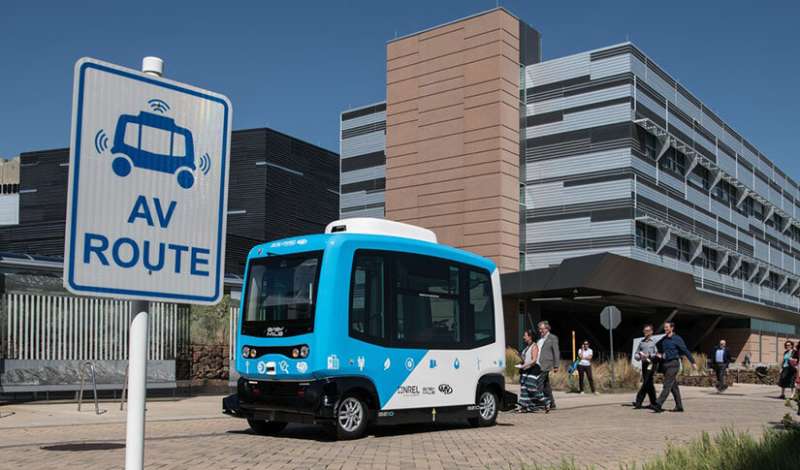Automated mobility district 'digital twin' provides insights for urban transportation systems

National Renewable Energy Laboratory (NREL) Researcher Stan Young has a vision of a downtown district characterized by transportation mobility systems that are as easy and efficient to use as the moving walkways found in airport terminals, but on a larger scale. While that may not be our exact future, his work on the Automated Mobility District (AMD) modeling and simulation toolkit makes it easier for researchers and city planners to quantify the advantages and disadvantages of similar transportation evolutions.
The AMD toolkit is a full mathematical model of emerging mobility in selected urban districts—a digital twin that can analyze the mobility and energy impacts of transportation systems in an area. The toolkit reviews the methods of transportation available and how easily that environment can adapt to the changing needs of its inhabitants. Researchers can use the AMD toolkit to analyze how mobility systems within an entire district interconnect and then use those insights to inform decisions regarding the introduction of new modes of transportation to a community.
"The AMD Toolkit moves past the basic analysis of connecting point A to point B," Young said. "We are looking at accessibility of resources in the district—such as food, healthcare, entertainment, and employment—to its inhabitants and to outside visitors."
The Impact of Emerging Technologies
Initial use of the AMD toolkit focused on the impact of low-speed automated shuttles in geofenced districts. A recent article from the NREL AMD toolkit development team—Lei Zhu, Jinghui Wang, Venu Garikapati, and Stan Young—in the Journal of the Transportation Research Board, "Decision Support Tool for Planning Neighborhood-Scale Deployment of Low-Speed Shared Automated Shuttles," outlines results from the AMD toolkit in Greenville, South Carolina. The toolkit analyzed the impact of deploying up to six shared automated vehicles (SAVs) at Clemson University's International Center for Automotive Research in Greenville County. The study determined that the addition of electrified SAVs providing shared mobility services would result in fuel savings from 11% to 38% for satisfying travel demand within the region. However, in this scenario, the addition of SAVs did not improve the vehicle miles traveled, occupant-free miles traveled, or travel time.
"These automated shuttles are really in their infancy," Young said. "There is a lot of room for growth and, with that, a lot of growing pains. We are excited by how these SAVs can improve, as well as how emerging mobility technologies can change the communities."
One example of emerging systems is the popular micro-mobility electric scooters. When mobile e-scooters appeared in cities across the United States, work on the AMD toolkit was well underway. The pay-per-use e-scooters, which can be located with a mobile app and ridden to any destination within their service areas, offered a real-life look at how new transportation options can transform the way we travel. Currently, e-scooters are only accessible to a narrow urban demographic; however, they epitomize the room for growth in urban environments. Researchers can use the AMD toolkit to analyze other innovative concepts to determine how effective they will be in any given area.
"The e-scooters confirmed the demand for these multi-modal environments," Young said. "If you provide a similar solution that services a larger demographic, it could radically transform mobility in these urban areas."
Future Challenges to Integrated Mobility
AMD modeling may also address the one crucial roadblock researchers have yet to fully address—determining optimal mobility options within the first mile from the user's point of origin and the last mile before the user's destination. If efficient and cost-effective transportation mobility systems are not immediately available within that "first mile, last mile" zone, then choices to travel by public transit and/or other modes more energy efficient than a personal automobile are not a viable option for public use.
Researchers at NREL who are developing the AMD toolkit within Young's Mobility Systems Team studied 10 specific deployment sites to better understand the key parameters necessary to successfully implement an automated electric shuttle system. One example of a site studied was a recent project within the city of Arlington, Texas, which looked to address the first-mile/last-mile challenge in conjunction with sporting events. An SAV shuttle service named Milo was deployed in a demonstration pilot to carry passengers to and from remote parking lots and the two major stadiums in the area known as the Entertainment District. During the 12-month period when Milo was active, the shuttle serviced a total of 78 stadium events. Researchers reviewed this project and other such projects in depth in the AMD Implementation Catalog: Insights from Ten Early-Stage Deployments.
Overall, the AMD modeling and simulation toolkit offers insights into a range of mobility options not covered by previous transportation analysis models. The toolkit builds on the existing open-source Simulation of Urban Mobility (SUMO) package and the Future Automotive Systems Technology Simulator developed at NREL.
More information: Lei Zhu et al. Decision Support Tool for Planning Neighborhood-Scale Deployment of Low-Speed Shared Automated Shuttles, Transportation Research Record: Journal of the Transportation Research Board (2020). DOI: 10.1177/0361198120925273





















